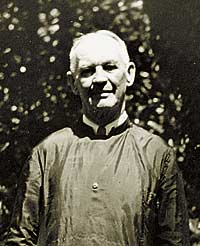 |
| Hans Holbein (the elder) Self-Portrait |
It's no secret in the fine arts that talent is genetic. It tends to run in families. Sometimes it's been known to skip a generation but many is the son or daughter, living in the shadow of an accomplished father or mother, who finds it an uphill struggle to match the greatness of the parent's work. In film, the Fonda family comes to mind. In painting, the Wyeth family; in music, the Bernsteins or the Gershwins; in architecture, the Wrights, I could go on and on. And in the majority of these cases, the offspring, while often exceptional, do not measure up to the success of the first generation. But it does happen. And when it does, for the father, it's a mixed blessing. On the one hand, every father wants to see his son succeed. Yet, think of the dismay of having your own outstanding work mistaken for that of your son. That's exactly what happened to a hard working, really quite talented German artist during the Northern Renaissance.
 |
| Ambrosius and Hans Holbein (the younger), silverpoint by Hans Holbein (the elder), 1511 |
His name was Hans Holbein. We've all heard the name, right? He's known today for his elegant portraits of a corpulent King Henry VIII of England. No, that's Hans Holbein the son. Art historians refer to him as Hans Holbein (the younger). This time we're talking about his father, Hans Holbein (the elder). His brother, Sigismund, was also a painter. He was born near Augsburg in German Bavaria about 1460. His father was a well-to-do leather worker who saw to it that his son studied with the great German painter, Schongauer. He married the daughter of a painter by the name of Brickmaer, and seems to have worked in several area cities of the time including, Ulm, Frankfort, Basle and Alsace. Records suggest that his travels may have been aimed at escaping indebtedness. In any case, his sons, Hans and Ambrosius (above, left), were born around 1500. Both he trained to become painters.
 |
| Death of the Virgin, 1490, Hans Holbein (the elder) |
The father's early work shows the influence of Roger van der Weyden, and then that of the Van Eycks. Later, picking up many Italian influences, he was the first German painter to soften his style, favoring the gentle, voluminous qualities of Mantegna and Perugino over the angular, linear style of Durer and others. Though he painted portraits, his best works are the numerous altarpieces he left scattered from Augsburg to Nuremberg. A particularly poignant one in Augsburg, painted around 1515 (photo unavailable), contains a self-portrait, along with likenesses of his two sons who may have helped him with the work. In it, the father points with pride to his namesake, perhaps realizing that his son already showed signs of surpassing him. Unbelievably, even before he died in 1520, indications are that papers were being forged to indicate work by the father had been done by the son. It's the kind of thing than make fathers prematurely gray; and no doubt adds a little silver to the heads of art historians as well.





















.jpg)

























